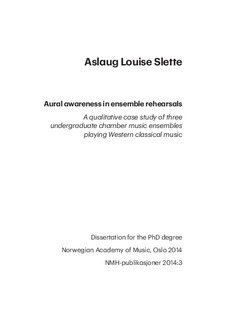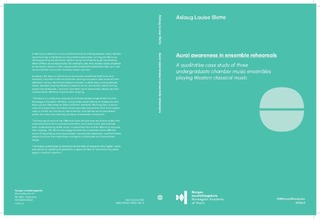| dc.description.abstract | Abstract
This thesis aims at understanding the roles and characteristics of aural awareness in ensemble rehearsals, within the contexts of higher music education and Western classical music. The overall idea of the subject area of aural training as a complementary discipline in undergraduate studies, is that it should inform and support performance activities, and lead to aural awareness. For example, one may expect music students to be aurally aware in their unsupervised, curricular ensemble rehearsals. However, the ways in which aural awareness manifests itself in such rehearsals, and how it informs problem-solving processes, has received little attention.
The following research problem is posed in the thesis: In what ways are undergraduate music students aurally aware during ensemble rehearsals, and how does their aural awareness influence their collaborative efforts to improve their playing? Two research questions further refine this problem, asking how aural awareness is part of ensembles’ problem-solving processes, and what kinds of tools the ensembles share in order to improve their playing. This problem area is explored through a qualitative, collective case study with three student chamber ensembles from the Norwegian Academy of Music. Video observations of rehearsals and focus group interviews have been chosen as data collection methods. Working from a sociocultural perspective, the thesis challenges the assumption that aural awareness is merely an individual phenomenon, and defines aural awareness within the collective learning situation of ensemble rehearsals.
The thesis suggests six kinds of tools that are shared by the students in the ensembles: activity, strategic, analytical, conceptual, interpretative, and performing tools. These tools operationalize aural awareness and mediate the students’ understanding of the music, in ways that inform their efforts to improve their playing. The thesis also suggests that there are different ways of negotiating aural awareness in ensemble rehearsals. A two-dimensional table explains the relations between a scale going from cooperation to collaboration, and a scale going from few or no, to several shared tools, showing four ways of negotiating aural awareness: expert negotiations, complete negotiations, incomplete negotiations, and personal negotiations.
The thesis concludes that aural awareness can play the roles as standby, basis for negotiation, and preparation in ensemble rehearsals. The characteristics of aural awareness in ensemble rehearsals are interpreted as craftsmanship, scholarship, and musicianship. Finally, the thesis concludes that these roles and characteristics of aural awareness in ensemble rehearsals can be seen as an Aural Awareness Space. The findings of the thesis contribute to the field of higher music education by providing tangible examples of how undergraduate students are aurally aware. The thesis as such contributes to the field of research into higher music education by assisting to establish a research field of "aural training pedagogy in musical practice," and by defining aural awareness in a collective learning situation through a sociocultural framework. | nb_NO |

